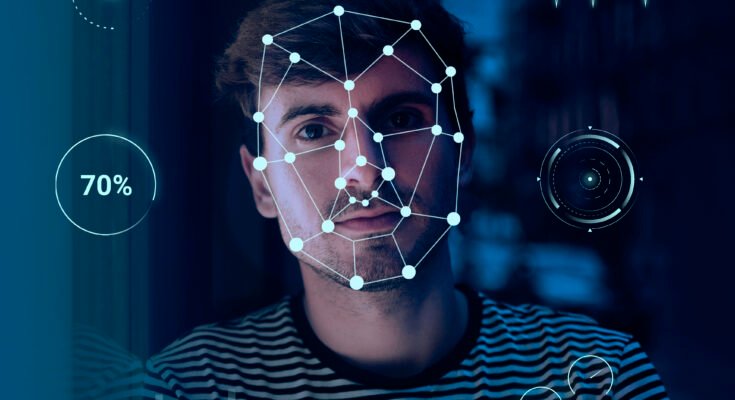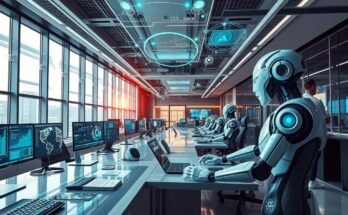Introduction
In today’s fast-changing world, artificial intelligence (AI) is changing many fields. It’s making a big difference in how we see and interact with our surroundings. This is especially true in image recognition and computer vision.
AI is making machines better at seeing and understanding pictures. It helps self-driving cars and advanced facial recognition systems work well. These AI tools are changing many areas, making things more automated and efficient.
This article takes you into the exciting world of AI in image recognition and computer vision. We’ll look at the basics, machine learning, and how it has evolved. By understanding these concepts, you’ll see the huge potential of AI in visual processing. This will prepare you for exploring its many uses and future possibilities.

Key Takeaways
- AI technology is revolutionizing the field of image recognition and computer vision, transforming various industries.
- AI-powered computer vision algorithms enable machines to perceive, interpret, and analyze visual data with unprecedented precision.
- The applications of AI in visual processing span from autonomous vehicles to advanced facial recognition systems.
- Understanding the fundamental principles and evolution of this technology is crucial to unlocking its full potential.
- This article explores the captivating world of AI in image recognition and computer vision, setting the stage for a deeper exploration of its real-world applications and future prospects.
Understanding the Fundamentals of Computer Vision and AI
The world of technology is always changing. Computer vision and artificial intelligence (AI) are at the heart of these changes. They help machines understand and analyze digital images better than ever before. Learning about these basics can help us see how they are changing our digital world.
Basic Principles of Digital Image Processing
Digital image processing is key to computer vision. It deals with handling and understanding visual data. This includes everything from taking pictures to breaking them down into useful information. Object detection and recognition, and image segmentation techniques are crucial here. They help machines spot and sort out visual details with great accuracy.
Role of Machine Learning in Visual Recognition
Machine learning is a big deal in visual data processing. It uses smart algorithms and models to help machines understand and classify images. This technology has led to huge leaps in object detection and recognition and more accurate image segmentation techniques.
Historical Evolution of Computer Vision Technology
The history of computer vision technology goes back to the early days of AI. Pioneers like Marvin Minsky and David Marr started it all in the 1960s and 1970s. Today, machine learning in visual data processing is everywhere. It’s changing how we use technology and shaping our digital future.
“The ability to see is a gift, but the ability to see what is not there is a true superpower.”
AI Technology in Image Recognition and Computer Vision
Artificial intelligence (AI) has changed how we see and understand images. It lets machines read and understand pictures. This is used in many areas, like recognizing faces and guiding self-driving cars.
Convolutional neural networks (CNNs) are key to this change. They are deep learning tools that excel in tasks like identifying objects in images. These networks work like our brains, picking out important details in pictures.
Deep learning for image analysis is also crucial. It uses big datasets and complex networks to spot patterns in images. This helps in medical imaging, satellite photos, and checking products.
The effects of computer vision algorithms go beyond what we see. They help track objects in real time and aid the visually impaired. AI is being used in many fields, showing its vast potential.
As AI and computer vision grow, they will change our lives more. They will help us make better decisions and find new ways to understand the world. The future looks bright with AI’s help in seeing and understanding our surroundings.
“The ability of machines to see, identify and process images in the same way that humans do has been a long-standing goal of artificial intelligence.”
| Technology | Application | Industry Impact |
|---|---|---|
| Convolutional Neural Networks | Image classification, Object detection, Image segmentation | Revolutionizing fields like healthcare, security, and autonomous vehicles |
| Deep Learning for Image Analysis | Medical imaging, Satellite imagery, Industrial inspection | Enhancing decision-making and enabling new forms of visual data analysis |
| Computer Vision Algorithms | Real-time object tracking, Assistive technologies for the visually impaired | Transforming surveillance, accessibility, and a wide range of applications |
Deep Learning Architectures and Neural Networks for Visual Processing
Visual processing has seen big changes thanks to deep learning. Convolutional neural networks (CNNs) are leading this change. They are key in many image recognition and analysis tasks.
Convolutional Neural Networks (CNNs) Explained
CNNs are special neural networks for visual data. They use local connectivity and shared weights to find important features in images. This makes them great for tasks like object detection and image classification.
Transfer Learning Techniques in Vision AI
Transfer learning in vision AI is exciting. It lets us use pre-trained CNN models for new tasks. By tweaking these models, we can get great results with less data. This speeds up the creation of AI visual apps.
Implementation of Advanced Computer Vision Algorithms
The field of deep learning for image analysis keeps getting better. Now, we can use advanced algorithms like instance segmentation and pose estimation. These are being used in many fields, from cars to medicine.
| Technique | Application | Key Benefits |
|---|---|---|
| Convolutional Neural Networks (CNNs) | Image classification, object detection, semantic segmentation | Efficient feature extraction, local connectivity, and shared weights |
| Transfer Learning | Rapid development of visual AI applications | Leveraging pre-trained models to achieve high performance with limited data |
| Advanced Computer Vision Algorithms | Instance segmentation, pose estimation, generative modeling | Improved accuracy, robustness, and versatility in visual processing tasks |
The future of computer vision and image recognition looks bright. Deep learning is driving innovation. From CNNs to transfer learning and advanced algorithms, the possibilities are endless.

Real-World Applications and Industry Implementation
AI technology in image recognition and computer vision is changing the game. It’s not just theory anymore. These tools are making a real difference in many industries, solving big challenges.
In healthcare, real-time video analytics and object detection and recognition are changing medical imaging. Radiologists use advanced image segmentation techniques to speed up diagnosis and better care for patients. The auto industry is also using these technologies to make driving safer. They help with everything from self-driving cars to spotting pedestrians.
The retail world is getting a boost from AI too. Stores can now track what customers do, manage stock, and even plan their layouts better. In security, real-time video analytics and object detection and recognition help police and surveillance systems spot dangers faster, keeping everyone safer.
AI in image recognition and computer vision is leading to new solutions in many fields. As these technologies grow, we’ll see even more exciting uses across different industries.

“The integration of AI-powered visual processing is unlocking unprecedented opportunities for businesses and communities to thrive in the digital age.”
Conclusion: Future Prospects and Emerging Trends
The future of ai technology in image recognition and computer vision looks bright. We can expect even more exciting developments. These will change how we see and interact with the world.
One trend is combining ai technology in image recognition and computer vision with new tech like augmented reality and the Internet of Things. This will create smart, interactive environments. It’s a new era for how we live and work.
Another trend is making machine learning in visual data processing easier for everyone. Soon, more people will use transfer learning in vision ai in different fields. This will lead to new ideas in healthcare, urban planning, entertainment, and e-commerce.
“The future of ai technology in image recognition and computer vision is filled with boundless potential, as we continue to push the boundaries of what’s possible with the convergence of cutting-edge technologies and human ingenuity.”
The ai technology in image recognition and computer vision field will keep growing. New ideas and uses will emerge. These changes will deeply impact our lives and society, bringing both excitement and transformation.

Challenges and Ethical Considerations in AI-Powered Visual Processing
Computer vision and deep learning are advancing fast. But, we must face the challenges and ethics they bring. Real-time video analytics raise concerns about privacy, bias, and responsible use.
Privacy is a big worry. Analyzing images and videos can invade our privacy. We need clear rules to protect our data while using these technologies.
Bias in AI is another challenge. If AI is trained on biased data, it can discriminate. We must keep checking and adjusting AI to make sure it’s fair for everyone.
Responsible Development and Deployment
It’s key to develop and use AI wisely. We must think about transparency, accountability, and possible bad outcomes. Working together is vital to make sure AI helps everyone.
| Challenge | Consideration |
|---|---|
| Privacy Concerns | Establishing clear guidelines and safeguards to protect individual privacy |
| Algorithmic Bias | Ensuring fair and inclusive computer vision algorithms through ongoing monitoring and adjustments |
| Responsible Development | Promoting transparency, accountability, and addressing potential unintended consequences |
As computer vision grows, we must tackle these issues. This way, we can enjoy the benefits of these technologies fairly and responsibly.

Getting Started with AI in Image Recognition and Computer Vision
Using Convolutional Neural Networks (CNNs) and transfer learning can unlock AI’s full power in image recognition and computer vision. By fine-tuning pre-trained models, you can quickly create solutions for object detection and more. This makes AI-driven image recognition and computer vision very powerful.
To use these advanced AI technologies, you need a good plan and the right team. First, find out where visual processing can help, like in quality checks or self-driving cars. Then, gather a team with skills in machine learning, computer vision, and coding. This team will help make your project a success.
When starting your AI journey, look into open-source tools like TensorFlow, PyTorch, and OpenCV. These tools are great for building and using your own models. They also have pre-trained models for tasks like object detection and recognition.
FAQ
What are the basic principles of digital image processing?
Digital image processing uses many techniques. These include getting images, making them better, fixing them, compressing them, and breaking them down. These steps help machines understand and analyze images.
How does machine learning play a role in visual recognition?
Machine learning, especially deep learning, has changed computer vision. These AI systems can spot patterns, find objects, and sort images well. This lets machines see and understand images in ways we couldn’t before.
What are the key historical developments in computer vision technology?
Computer vision has grown a lot over the years. It started with simple systems and now uses deep learning. Big steps include new ways to find features, the use of neural networks, and better computers and data.
How do Convolutional Neural Networks (CNNs) work for image analysis?
CNNs are great for working with images. They use the image’s layout to find important parts and learn patterns. This helps them do tasks like finding objects, sorting images, and understanding what’s in an image.
What is transfer learning and how can it be applied in vision AI?
Transfer learning is when a model is used for a new task after being trained on another. In computer vision, it lets developers use big models for new tasks. This saves time and effort.
What are some real-world applications of AI-powered image recognition and computer vision?
AI in computer vision is used in many areas. It helps in healthcare, with self-driving cars, in retail, and for security. It makes things like medical analysis, automatic checkout, and surveillance better.
What are some of the key challenges and ethical considerations in AI-powered visual processing?
There are big challenges and ethics in AI. We need to make sure AI is fair and clear. We also have to protect privacy, avoid bias, and use AI for good.
How can individuals and organizations get started with implementing AI in image recognition and computer vision?
Starting with AI in image recognition means finding where it can help. Choose the right tools and build a team with the right skills. Follow best practices for data and model use.



